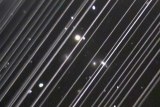SpaceX plans to launch thousands of satellites: Is this the end of dark skies? – ABC News
The night sky may feel vast, but it’s about to get very crowded up there for scientists peering into distant galaxies.
Elon Musk’s SpaceX is one of several companies that intend to launch vast constellations of small satellites into low-Earth orbit.
This boom in space objects means more light and more noise in the sky, when optical and radio astronomers prefer darkness and quiet for their instruments to work without interference.
Mr Musk’s Starlink project, which aims to offer broadband internet in the United States and Canada in 2020, has already launched 120 low-Earth-orbit satellites — with plans for tens of thousands more.
This development comes as scientists are building bigger telescopes to see further. The signals they’re looking for are weaker and could be somewhat drowned out by this new activity closer to Earth, according to Dr Cathryn Trott, a radio astronomer at Curtin University’s International Centre for Radio Astronomy Research.
“Having those satellites be very bright just makes it more and more difficult as we try and hear deeper and deeper into the universe,” she said.
External Link: Clarae Martínez-Vázquez tweet
SpaceX, along with communication satellite operators Kepler Communications and Swarm Technologies, has begun the initial regulatory process to operate “space apparatus” in Australia.
The Australian Communications and Media Authority is currently considering a proposal to include the trio in the Foreign Space Objects Determination, so they can eventually apply to offer their services here.
But the consequences for astronomy are not yet fully clear. The International Astronomical Union is one of many groups to voice concerns this year.
“We do not yet understand the impact of thousands of these visible satellites scattered across the night sky,” it said in a statement.
‘The satellites glint’
SpaceX satellites have already begun appearing in images taken by astronomical telescopes, which troubles Monash University astronomer Michael Brown.
It can be problematic to repair images in which they appear.
“You’ll lose the data where those satellites are trailed across it,” he said.
When first launched, SpaceX’s satellites are lower in the sky — clustered and more visible.
But Dr Brown said they could still cause trouble when they reach higher orbit — particularly at the start and end of each night.
While it may be dark on Earth, the satellites can still be illuminated by the sun at altitude and appear bright.
“We’ve heard of images where the satellites glint, which is a little bit like when you shine a mirror at someone and it produces a bright flash of light,” Dr Brown said.
The International Dark-Sky Association is also concerned about the new constellations, not only for scientists, but for all of us and our relationship with the night sky.
A SpaceX spokesperson said it is working to make the base of Starlink satellites black “to help mitigate impacts on the astronomy community”.
Star formation data could be drowned out
It’s not only optical interference — the growth of mega satellite constellations also troubles radio astronomers.
Satellite constellations in relatively low orbit can have uplink and downlink frequencies that may overlap with frequencies of interest to scientists, explained Dr Trott.
A number of frequency bands are widely protected for astronomy — around where hydrogen emissions sit, for example.
Some molecules in space, however, emit radio waves in unprotected frequencies that are then observed from Earth.
These molecular lines can appear in clusters where stars are forming — called stellar nurseries. The noise from a satellite at the same frequency will be louder due to its proximity, potentially drowning out significant data.
External Link: Didier Queloz tweet
Our understanding of stellar nurseries and stellar evolution may be impacted by these satellites, Dr Trott suggested.
“It just means that you can’t observe at those frequencies, so that’s information that we’ve lost,” she said.
Satellite constellations can also mess with astronomical instruments by reflecting the Earth’s radio frequencies back at it.
As they pass over a radio telescope, for example, they can reflect radio stations kilometres away back at the instruments.
This is especially frustrating as such telescopes are often built in remote places to avoid interference — the site of the Square Kilometre Array in Western Australia, for example, where some instruments are already online.
“That’s a nice radio-quiet site, but we can actually see reflections off satellites of radio stations from Perth and from Geraldton,” Dr Trott said.
‘By the time the damage is done, it will be too late’
As well as making the base of its future satellites darker to address light reflection, SpaceX said it is working with astronomy groups to try and ensure their work isn’t affected.
Dr. Benjamin Longmier, the cofounder of Swarm, which is also being considered by ACMA, said astronomy is important to the company.
“Swarm also chose to limit the number of satellites to only 150, which is a significantly lower number than the proposed mega-constellations,” he said.
It would be useful for government to facilitate a dialogue with these companies to protect Australian astronomy, Dr Trott suggested, amid ongoing talks between SpaceX and the global scientific community.
Minister for Science Karen Andrews said Australia is working with satellite-constellation businesses to understand and manage the impacts.
“Engagement to date has indicated many of the potential impacts to astronomy will be minimal and manageable,” she said.
“Our government agencies will continue to work closely with the space and astronomy communities as new technologies are developed.”
Compatibility with radioastronomy services is one thing ACMA considers when a satellite operator applies for an Australian license, an ACMA spokesperson said.
However, responsibility for the SpaceX satellite system is a matter for the United States Federal Communications Commission.
Dr Alice Gorman, a space archaeologist at Flinders University, is concerned that astronomers are up against powerful private corporations.
“My reading of the situation is that astronomers are going to be just asked to suck it up,” she said.
“It’s going to be one of those things that by the time the damage is done, it will be too late to reverse it.”







